In praise of Jasmine
Of all the myriad creations of god not all get noticed. It is believed that world was created with so many variations for man to see and enjoy. Unfortunately, man has no time even to stand and stare. Man’s search for material benefits has completely distanced him from nature. Still she does not fail to hook the runaways by her generosity. If man is indifferent to nature, nature adopts newer ways and means to bring him round.
The most charming, colorful flowers are the best enticers for those who cannot see or feel the variety of flowers which are numerous . They serve the people in various forms as spreading fragrance, color, taste, touch and even sound. Of these too, only a few varieties are blessed to get closer to man. Among these a very few top the list by their fragrance, color, sustenance and above all utility. They are the world-famous Jasmine. This magic word draws his attention to recollect and enjoy the fragrance from where he is.
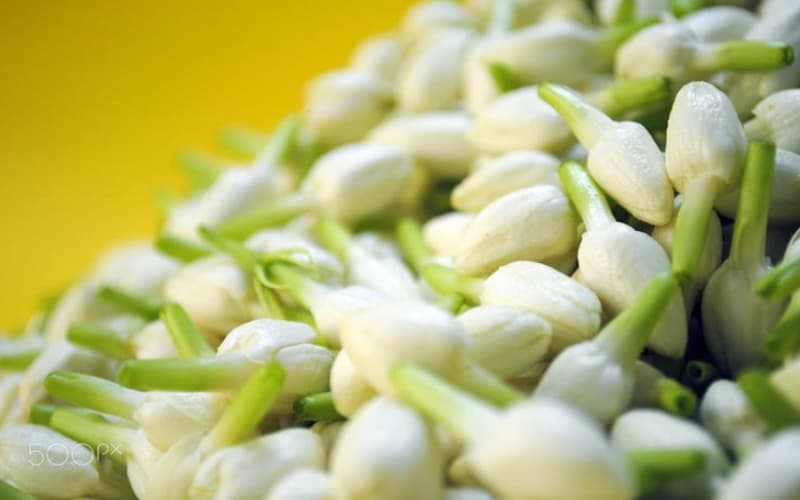
The very name Jasmine suggests the famous temple city Madurai in the southern region of India. Madurai and Jasmine are synonymous so to say. One may wonder what is so great about it. Such of them should once enjoy the closeness of it that he would never avoid. Its value is known worldwide that it has the pride of being patented. Visitors from different countries do not fail to have a strand of Jasmine tied to their wrist. Seeing them enjoy closeness of the flower speaks volumes of its greatness.
Jasmine is a comparatively tiny flower that spreads intoxicating fragrance. It is white in color, and rarely yellow. The plant as such is only four to five feet tall. Sometimes it grows as creepers too. It is known by many names with malli attached to it such as nithya malli, adukku malli, gundu malli, mullai, kattumalli and many more. Mogra, chameli, malligai, malli puvuu are some names state wise. In the neighboring countries like Hawaii, Indonesia, Philippines too the name varies like Jasminum sampac, Royal Jasmin. The variations are not much so far as its fragrance is concerned. The variation is mostly in the number of petals as single, double and many petals. As to their life aspect they sustain longer period unlike many flowers that wither away or wane in a short period. Moreover, the thickness of the petals enables its longevity. During the peak season, the Madurai people particularly, stitch artistically these flowers on the plaits of young girls and kids. Invariably all houses would display a picture taken of the hand work or more rightly head work of the ladies. Of late, it is used only for the bride and bridegroom.
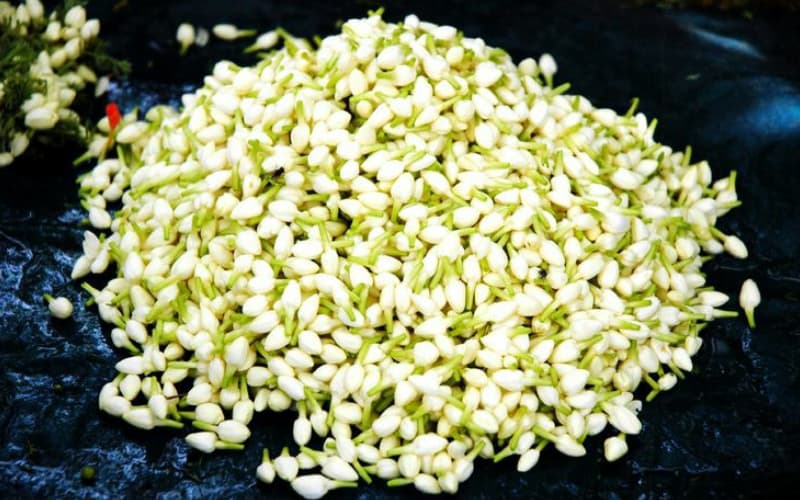
One may wonder why so much importance to Jasmine in Madurai. The answer is the quality of the flower. It is due to the fact that it is grown only in and around Madurai as Arupukottai, Thiru Mangalam, Nilakota to name a few for their uniqueness of moist, well drained loamy soil. The suitability of the soil and climatic condition result in good yield that they are transported through special planes. The marketing of these flowers commenced in a small way. Around the year 1930 small planes were used to fly between Madras, now Chennai and Madurai. To avoid empty trip back it was used to carry back Jasmine flowers. This led to the extraction of scent from the flower to prepare perfumes. In course of time, both the blossoms and marketing derived momentum that tons and tons of flowers are exported all over the world to reach the status of industry.
The neighboring countries like Malaysia, Indonesia, Hawaii too eagerly grow Jasmine plants for which saplings are grown with great care and transported from Thangachi madam near Rameswaram. These countries have given national status to Jasmine. They seem to vary from the Indian variety mainly because of the soil condition and the direct heat from the sun - particularly during the months of March, April, and May, when the sun would be at its peak.
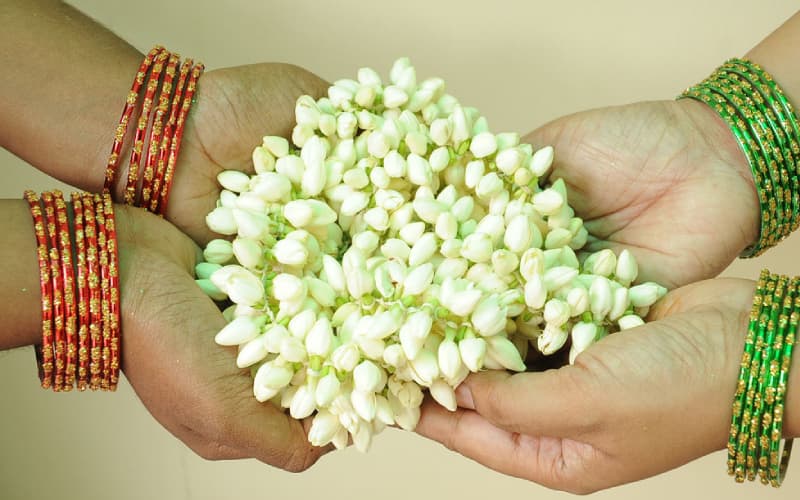
The flowers are normally threaded in various forms thick, or thin, long, or short, for the use of the reigning deity Meenakshi of Madurai. Baskets in good number are spared for the goddess to be decked with these garlands of Jasmine. These flowers are religiously offered to gods. Mythological connection needs to be thrown light upon. In classical music of South India, a term Mallikarjuna is used. This refers to a mythological fact, Adi Shankara who trekked all parts of India - North, South, East and West to propagate Advaita arrived at a place called Srisaila, a Siva Sthala in Andhra. He eyed upon a tree which was known as Arjuna tree. It was entirely covered with Jasmine, familiar as malli. It is also believed that Arjuna did penance sitting under the tree. And it came to be known as Mallikarjuna tree. So, it is to be noticed that such a tree had been existing from time immemorial, just as Rama Sethu which has been under constant scrutiny for its brilliance. Jasmine flowers are offered to goddess Meenakshi every night for the everyday ceremony of leading her to retire.
The use of Jasmine on auspicious occasions is prominent. Garlands and bouquets add more beauty and charm to the bride and groom. The guests too are offered these flowers to mark the solemnity of the wedding. This creates a positive vibration for all those present there. One interesting fact in connection with Jasmine is the bride is always pleased with a gift of stringed Jasmine. A hero in love often describes his fiancée comparing her with Jasmine. Ever so many songs specially in the southern region introduce Jasmine in their lyrics.
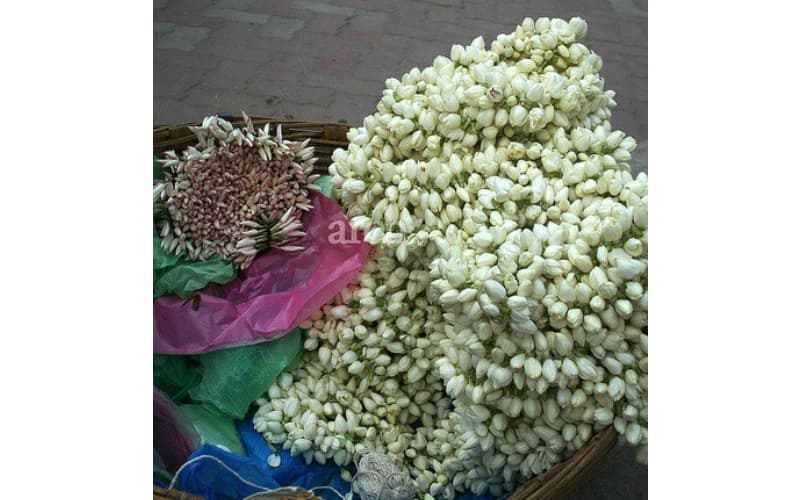
Besides the ceremonial aspect, the medicinal value of the flower needs to be mentioned. Jasmine is used to check or control the secretion of breast milk of a mother. At the same time, a mother who has to feed her child is not allowed to use Jasmine as it would have adverse effect. The Ayurveda treatment provides a list of remedies to cure various ailments like constant headache, swelling of joints, asthma, stomach problems, sleeplessness and many more. All parts of Jasmine plant as leaves, buds, flowers fresh and dried are used for treating different ailments.
Mythological connection needs to be thrown light upon. In classical music of south India, a term Mallikarjuna is used. As previously mentioned, about its connection to Arjuna and Adi Shankara. In addition to this is the story of king Pari who sacrificed his royal chariot for a creeper to grow well, he was to be remembered as Pari Vallal and Mullaiku ther kodutha Pari.
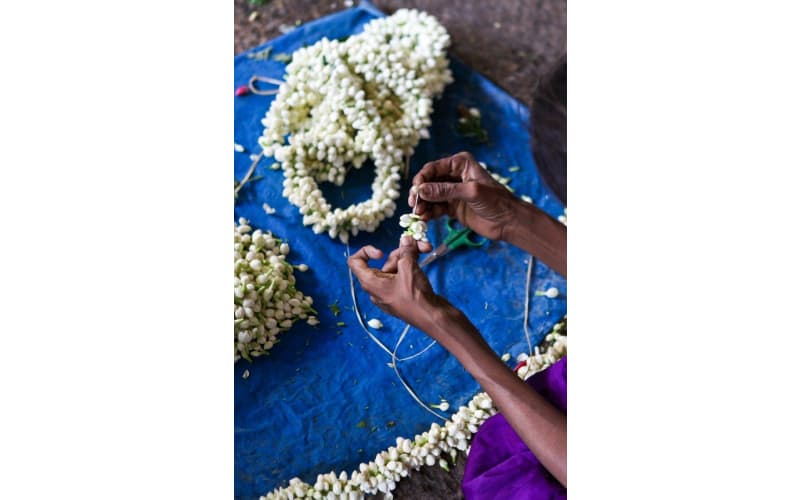
Dr. Uma Kannan popularly known as ‘Jasmine lady of Madurai’ has brought out a book titled Madurai Malligai purely on Jasmine. She has been responsible for the flowers to receive geographical index tag. She conducts workshop at regular intervals in which women participate in good number to learn different patterns, marketing by which their financial standard is improved.
In a lighter tone it can be said that Jasmine has become an inseparable part of our life that some draw a comparison between Jasmine and Idly. If the idly is soft and white they appreciate saying that it is as soft and white like malligai poo. Thus, Malligai or Jasmine, the Queen of fragrance ever continues to rule the world with her spell of magic over us.
NEXT ARTICLE